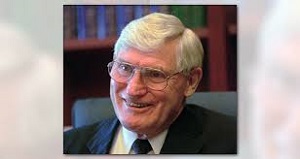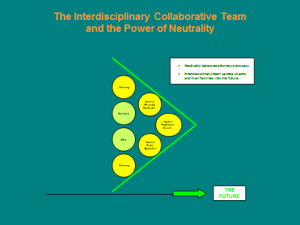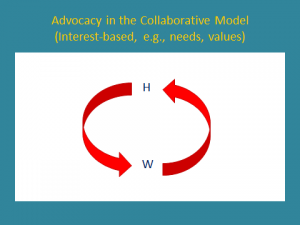Thirty years ago, in 1990, a family lawyer in Minneapolis named Stu Webb had an idea. He thought the idea was good enough to share with the Minnesota Supreme Court Justice at the time, “Sandy” Keith. Stu’s letter of February 14, 1990, to Chief Justice Keith starts out:
Dear Sandy,
I met you at a party . . . several years ago.
Stu did not even know Sandy Keith! But undaunted, Stu plows ahead:
I think I’ve come up with a new wrinkle that I’d like to share with you. One of the aspects of mediation that I feel is a weakness is that it basically leaves out input by the lawyer at the early stages [of the mediation process]. . .. By that I don’t mean adversarial, contentious lawyering, but the analytical, reasoned ability to solve problems and generate creative alternatives and create a positive context for settlement.
…[Y]ou and I have both experienced, I’m sure, those occasional times, occurring usually by accident, when in the course of attempting to negotiate a family law settlement, we find ourselves in a conference with the opposing counsel, and perhaps the respective clients, where the dynamics were such that in a climate of positive energy, creative alternatives were presented. In that context, everyone contributed to a final settlement that satisfied all concerned—and everyone left the conference feeling high energy, good feelings and satisfaction. More than likely, the possibility for a change in the way the parties related to each other in the future may have greatly increased. As a result, the lawyers may also develop a degree of trust between them that might make future dealings more productive.
So, my premise has been: Why not create this settlement climate deliberately? . . . I would do this by creating a coterie of lawyers who would agree to take cases . . . for settlement only. . . . I call the attorney in this settlement model a collaborative attorney, practicing in that case collaborative law.
This little history might end here but Chief Justice Sandy Keith did respond to Stu’s letter(!!):
Dear Stu,
Many thanks for one of the most thoughtful letters I have received these past months. Congratulations . . . on the model you are setting up in the family law area. . . . I know it will be successful. . . . I think you have thought it through better than most attorneys and I think it is a very valid model in the family law area.
Both Stu Webb and Sandy Keith were pioneers in family law practice. Sandy was a pioneer in using a mediation process in family law; Stu was a pioneer in creating a collaborative process in family law. Thanks to them, out-of-court processes—mediation and collaboration—are benefiting clients all over the world. Sandy Keith—former Minnesota Supreme Court Justice, former Lieutenant Governor, former State Senator, and former family law attorney—died October 3, 2020. His support of the Collaborative process is not forgotten.
Footnote from Stu Webb, 10/6/20:
Here is the link to the Star Tribune Obituary of Sandy Keith, who died last Saturday, October 3 at 91! I could say that Sandy is responsible for releasing Collaborative Law to the world! In 1990, when I self-questioned the credibility of the concept, I wrote him a letter describing the process and, essentially, highlighting some potential advantages of it over mediation (which was his former practice specialty!) Instead of defensively ‘shooting it down’, he Immediately sent a short note back, basically saying ‘wonderful, go for it’! And years later, I had the honor of participating in a Collaborative Law case with him in my home office! WHAT A GUY!!
Star Tribune Obituary \Sandy Keith: https://www.startribune.com/sandy-keith-former-minnesota-supreme-court-chief-justice-dies/572638202/
About The Author Tonda Mattie, has been a Family Law attorney for over 40 years and has practiced exclusively Collaborative Family Law since 2006. She has been involved in the Collaborative Law movement since 1992. She has been past President and past Co-President of the Collaborative Law Institute (CLI) of Minnesota. She has headed the CLI Training Committee as chair or co-chair since 2004. She is engaged in the practice of her dreams using a collaborative process that 1) allows good people to be their best despite the crisis they are in; 2) is centered on the well-being of the children; 3) creates a safe environment for difficult conversations; 4) focuses on the future rather than on blame and past grievances; 5) identifies and meets the needs and interests of all family members; 6) empowers parties to control and create their own mutual settlement; and 7) creates a climate in which healing can begin to occur. Visit her website at www.mndivorce.com
Tonda Mattie, has been a Family Law attorney for over 40 years and has practiced exclusively Collaborative Family Law since 2006. She has been involved in the Collaborative Law movement since 1992. She has been past President and past Co-President of the Collaborative Law Institute (CLI) of Minnesota. She has headed the CLI Training Committee as chair or co-chair since 2004. She is engaged in the practice of her dreams using a collaborative process that 1) allows good people to be their best despite the crisis they are in; 2) is centered on the well-being of the children; 3) creates a safe environment for difficult conversations; 4) focuses on the future rather than on blame and past grievances; 5) identifies and meets the needs and interests of all family members; 6) empowers parties to control and create their own mutual settlement; and 7) creates a climate in which healing can begin to occur. Visit her website at www.mndivorce.com






 In
In 


 Recently I received a referral from Kristin, a client I represented in 2011 in her collaborative divorce. In thanking her for the referral, I took the opportunity to ask her how she was doing. With her permission, her response is reproduced below. At the time of her divorce, Kristin and her husband had two (2) children ages 10 and 12.
Hi Tonda,
Nice to hear from you. I will fill you in with some detail for examples of what can lay on the other side of divorce to help you give hope to your clients going through this painful process. Everyone is doing well here; the kids are doing really well splitting their time between our 2 households (4 miles apart).
Tom and I have a much better relationship now than when we were getting divorced. We talk several times per week and text, usually daily, mostly regarding kids’ stuff like coordinating activities/homework and just general parenting issues. We also try to meet for coffee sometimes to discuss things more in depth like holidays and vacation planning and kids’ milestones. We see each other at their basketball games, tennis matches, orchestra concerts, etc, even holidays sometimes, and usually sit together with our new spouses. Tom and I both got re-married a couple of months ago and Tom and his wife are expecting a baby in March. I married a pharmacist that I met after the divorce and we got married in Yosemite in August of this year. The four of us get along well and the kids get along well with both our spouses so I have nothing but great things to say about the collaborative process. It really helped us to avoid a lot of un-pleasantries and keep our family together without staying married, which is really great.
I hope all is well with you and your practice. I will continue to recommend people look into collaborative divorce as an option. It has been very helpful to us to use the divorce agreement as a structure, but we stay very flexible with rearranging schedules, holidays and vacations etc. We have actually never even had an argument since the divorce. It has helped us build a sense of cooperation and the
Recently I received a referral from Kristin, a client I represented in 2011 in her collaborative divorce. In thanking her for the referral, I took the opportunity to ask her how she was doing. With her permission, her response is reproduced below. At the time of her divorce, Kristin and her husband had two (2) children ages 10 and 12.
Hi Tonda,
Nice to hear from you. I will fill you in with some detail for examples of what can lay on the other side of divorce to help you give hope to your clients going through this painful process. Everyone is doing well here; the kids are doing really well splitting their time between our 2 households (4 miles apart).
Tom and I have a much better relationship now than when we were getting divorced. We talk several times per week and text, usually daily, mostly regarding kids’ stuff like coordinating activities/homework and just general parenting issues. We also try to meet for coffee sometimes to discuss things more in depth like holidays and vacation planning and kids’ milestones. We see each other at their basketball games, tennis matches, orchestra concerts, etc, even holidays sometimes, and usually sit together with our new spouses. Tom and I both got re-married a couple of months ago and Tom and his wife are expecting a baby in March. I married a pharmacist that I met after the divorce and we got married in Yosemite in August of this year. The four of us get along well and the kids get along well with both our spouses so I have nothing but great things to say about the collaborative process. It really helped us to avoid a lot of un-pleasantries and keep our family together without staying married, which is really great.
I hope all is well with you and your practice. I will continue to recommend people look into collaborative divorce as an option. It has been very helpful to us to use the divorce agreement as a structure, but we stay very flexible with rearranging schedules, holidays and vacations etc. We have actually never even had an argument since the divorce. It has helped us build a sense of cooperation and the 